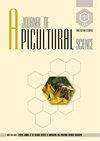蜂花粉提取物作为潜在抗氧化剂和α-淀粉酶和α-葡萄糖苷酶抑制剂的体外评价
IF 0.8
4区 农林科学
Q4 ENTOMOLOGY
引用次数: 17
摘要
摘要本研究旨在测定蜂花粉的抗氧化和抗糖尿病特性。提取物的苯酚含量分别为1.43、2.04、2.10和1.79mg没食子酸g-1。总黄酮含量分别为0.78、1.39、0.86和0.79mg没食子酸g-1。蜂花粉提取物具有清除自由基和降低血糖的潜力,这是由于酚类和类黄酮的存在。乙醇水提取物对HRS和TAC的IC50最低,分别为0.53mg/mL和0.25mg/mL,说明该提取物减轻了羟基自由基的破坏作用。甲醇提取物抑制DPPH的IC50最低(0.21mg/mL),因此它能够清除DPPH自由基。乙醇提取物对2,2-氨基-双(3-乙基苯并噻唑啉-6-磺酸的抑制作用IC50最低(0.04 mg/mL),因此它可以保护活细胞免受ABTS阳离子的影响。乙醇水提取物对α-淀粉酶的抑制作用更高(4.51 mg/mL)而水提取物对α-葡萄糖苷酶的抑制作用更强(0.60 mg/mL),这减缓了二糖的分解并减少了血液中的糖积累。蜂花粉具有潜在的抗氧化和抗糖尿病活性。本文章由计算机程序翻译,如有差异,请以英文原文为准。
Bee Pollen Extracts as Potential Antioxidants and Inhibitors of α-Amylase and α-Glucosidase Enzymes In Vitro Assessment
Abstract The study was conducted to determine the antioxidant and anti-diabetic properties of bee pollen. The phenol content of extracts was 1.43, 2.04, 2.10 and 1.79 mg gallic acid g-1, respectively. Total flavonoid content was 0.78, 1.39, 0.86 and 0.79 mg gallic acid g-1 respectively. Bee pollen extracts have the potential to scavenge free radicals and lower blood glucose due to the presence of phenols and flavonoids. The aqueous-ethanol extract had the lowest IC50 for HRS and TAC, 0.53mg/mL and 0.25mg/mL respectively, which depicts that this extract alleviates the destructive effect of hydroxyl radicals. Methanol extract had the lowest IC50 0.21 mg/mL) for DPPH inhibition, hence it was able to scavenge the DPPH radicals. Ethanol extract had the lowest IC50 (0.04 mg/mL) for 2, 2-azino-bis (3-ethylbenzothiazoline-6-sulfonic acid inhibition, hence it can protect living cells from ABTS cations. The aqueous-ethanol extract displayed higher inhibition of α-amylase (4.51 mg/mL) while the aqueous extract exhibited a higher inhibition of α-glucosidase (0.60 mg/mL), which slows down the breakdown of disaccharides and reduces sugar buildup in the bloodstream. Bee pollen has potential antioxidative and antidiabetic activity.
求助全文
通过发布文献求助,成功后即可免费获取论文全文。
去求助
来源期刊

Journal of Apicultural Science
ENTOMOLOGY-
CiteScore
1.70
自引率
0.00%
发文量
9
审稿时长
>12 weeks
期刊介绍:
The Journal of Apicultural Science is a scientific, English-language journal that publishes both original research articles and review papers covering all aspects of the life of bees (superfamily Apoidea) and broadly defined apiculture. The main subject areas include:
-bee biology-
bee genetics-
bee breeding-
pathology and toxicology-
pollination and bee botany-
bee products-
management, technologies, and economy-
solitary bees and bumblebees
 求助内容:
求助内容: 应助结果提醒方式:
应助结果提醒方式:


